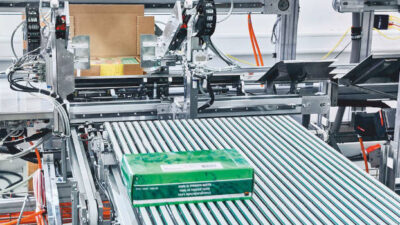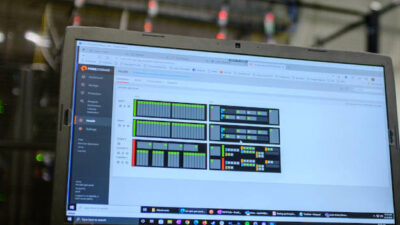Researchers at the University of Utah connect size of catalyst particles, their electronic properties, and chemical reaction speed.
Universityof Utahchemists have demonstrated the first conclusive link between the size ofcatalyst particles on a solid surface, their electronic properties, and theirability to speed chemical reactions. The study is a step toward the goal ofdesigning cheaper, more efficient catalysts to increase energy production,reduce Earth-warming gases and manufacture a wide variety of goods frommedicines to gasoline.
|
Microscopic bimetallic catalyst. Source: My Green Treasure.
|
Catalysts are substances that speed chemicalreactions without being consumed by the reaction. They are used to manufacturemost chemicals and many industrial products.
Catalysts are used in 90% of U.S. chemicalmanufacturing processes and to make more than 20% of all industrial products,and those processes consume large amounts of energy, according to the U.S.Department of Energy (DOE). In addition, industry produces 21% of U.S.Earth-warming carbon dioxide emissions, DOE says.
Thus, improving the efficiency of catalysts is"the key to both energy savings and carbon dioxide emissions reductions,"the agency says.
Catalysts also are used in drug manufacturing; foodprocessing; fuel cells; fertilizer production; conversion of natural gas, coalor biomass into liquid fuels; and systems to reduce pollutants and improve theefficiency of combustion in energy production.
"One of the big uncertainties in catalysis isthat no one really understands what size particles of the catalyst actuallymake a chemical reaction happen," says Scott Anderson, a University of Utahchemistry professor and senior author of the study. "If we couldunderstand what factors control activity in catalysts, then we could makebetter and less expensive catalysts.
"Most catalysts are expensive noble metalslike gold or palladium or platinum," he adds. "In a gold catalyst,for example, most of the metal is in the form of large particles, but thoselarge particles are inactive and only nanoparticles with about 10 atoms areactive. That means more than 90% of gold in the catalyst isn’t doing anything.If you could make a catalyst with only the right size particles, you could save90 percent of the cost or more."
In addition, "there’s a huge amount ofinterest in learning how to make catalysts out of much less expensive basemetals like copper, nickel, and zinc," Anderson says. "And the way you aregoing to do that is by tuning their chemical properties, which means tuning theelectronic properties because the electrons control the chemistry."
The idea is to "take a metal that is notcatalytically active and, when you reduce it to the appropriate size[particles], it can become catalytic," Anderson says. "That’s the focus of ourwork–to try to identify and understand what sizes of metal particles areactive as catalysts and why they are active as catalysts."
The new study used palladium particles of specificsizes that were deposited on titanium dioxide and used to convert carbonmonoxide into carbon dioxide. The study not only showed how catalytic activityvaries with catalyst particle size, but that the researchers have also beenable to correlate that size dependence with observed electronic differences inthe catalyst particles.
Andersonsays it is the first demonstration of a strong correlation between the size andactivity of a catalyst on a metal surface and electronic properties of thecatalyst.
Using an elaborate apparatus in Anderson’s laboratory, the chemists aimed alaser beam to vaporize palladium, creating electrically charged, palladiumnanoparticles in a vapor carried by a stream of helium gas.
Electromagnetic fields are used to capture the particles and send them througha mass spectrometer, which selects only the sizes of palladium particles Anderson and colleagueswant to study. The desired particles then are deposited on a single crystal oftitanium oxide that measures less than a half-inch on a side.
Next, the chemists use various methods tocharacterize the sample of palladium catalyst particles–specifically thepalladium catalyst’s electronic properties, physical shape, and chemicalactivity.
As the size of a catalyst metal particle is reducedinto the nanoscale, its properties initially remain the same as a largerparticle, Andersonsays. But when the size is smaller than about 10 nanometers–containing about10,000 atoms of catalyst–the movements of electrons in the metal are confined,so their inherent energies are increased.
When there are fewer than about 100 atoms incatalyst particles, the size variations also result in fluctuations in theelectronic structure of the catalyst atoms. Those fluctuations strongly affectthe particles’ ability to act as a catalyst, Anderson says.
Previous experiments documented that electronic andchemical properties of a catalyst are affected by the size of catalystparticles floating in a gas. But those isolated catalyst particles are quitedifferent than catalysts that are mounted on a metal oxide surface–the way thecatalyst metal is supported in real industrial catalysts.
Access other Control Engineering contentrelated to sustainability research:
- Universityof Kentucky increases contributions to sustainable manufacturing program
- Departmentof Energy awards grants for engine efficiency and emissions capture research
- CyboSoftwins DOE technology development research grants
– Edited by David Greenfield , editorial director
Control Engineering Sustainable Engineering News Desk



